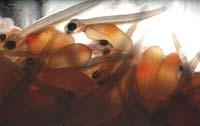Gills before breathing for ion exchange

The development of trout larvae suggests that gills were born for ion exchange
Before oxygen uptake and the elimination of carbon dioxide, gills begin to exchange ion in the larvae of rainbow trout. Based on this, researchers at British Columbia University have concluded that gills were created to respond to this second need and not to breathe.
As with oxygen and carbon dioxide, fish are continuously exchanging ions with the outer environment. Rainbow trout and other freshwater fish should be especially careful not to lose the ions in this exchange, as the outer environment has a lower ion concentration than its blood.
Both functions are performed by adult fish by sacks. Larvae, on the other hand, make exchanges through the skin during the initial stages of development, and gradually specialize and it is the gills that take care of it. At British Columbia University we wanted to know which of these two functions begin to be performed earlier on the rainbow trout larvae, suggesting what functions it responds to in evolution.
The larvae were placed in split boxes, with the head on one side and the body on the other. Thus, when the gills began to work, in the area of the head would see more tricks than in the part of the body, because the skin would stop performing the exchange. For they saw that the gills began to breathe in the first ion exchange and ten days later.





